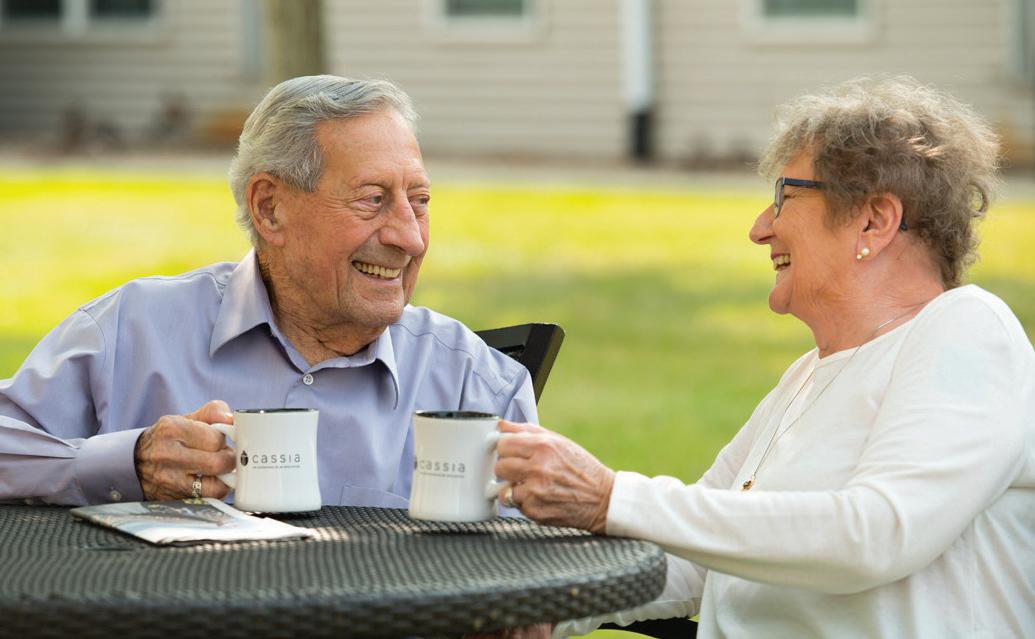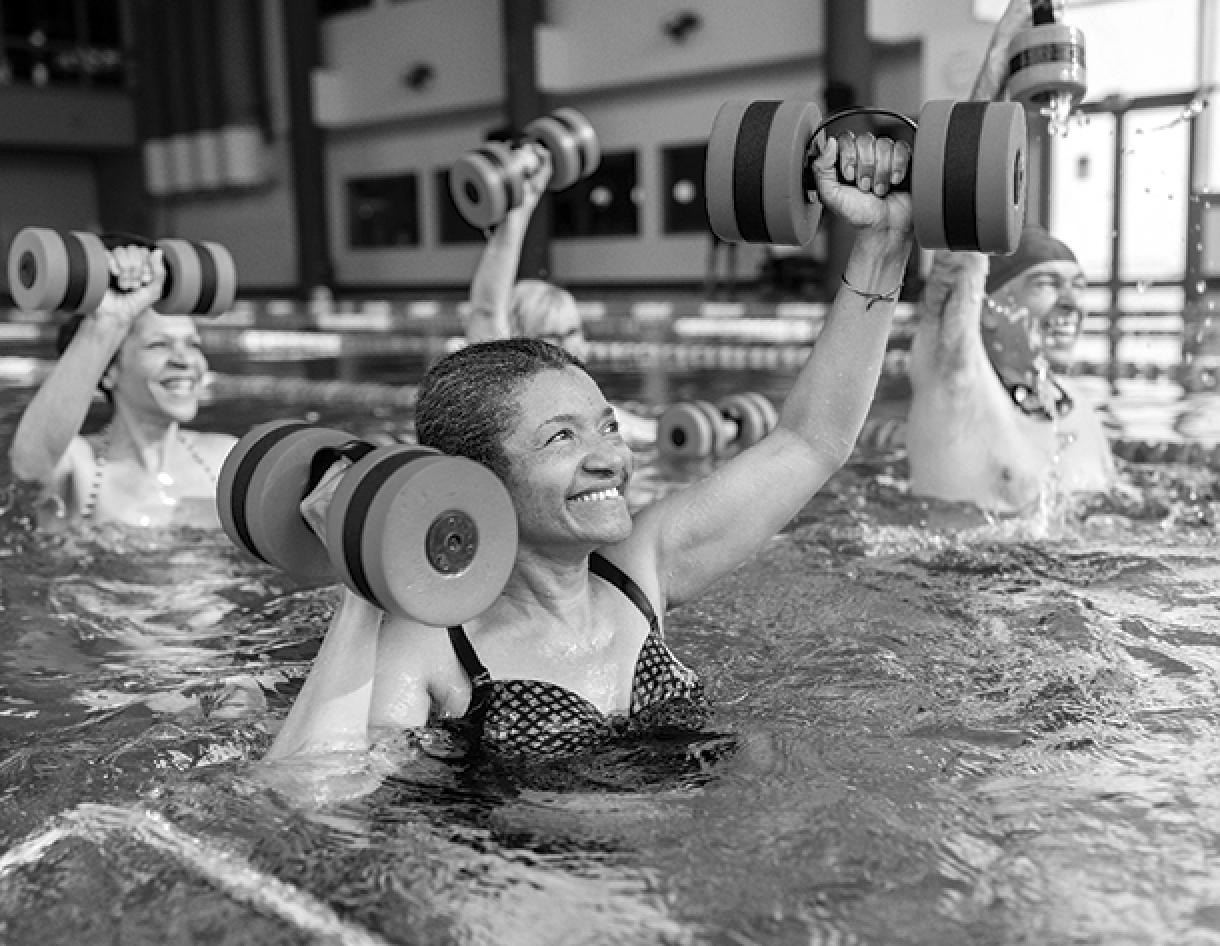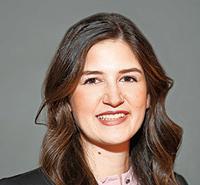

SENIOR










Activities for seniors with limited mobility
Physical activity is a valuable tool in the fight against chronic disease and other conditions. In fact, the Cleveland Clinic highlights physical activity among its nine ways to prevent disease in an effort to live a long and rewarding life.
Children, adolescents, young adults, and even men and women in middle age may not face too many physical hurdles when they try to exercise, but seniors are not always so lucky. Aging men and women with mobility issues may wonder if they can reap the rewards of physical activity, and thankfully there are many ways to exercise even if getting up and going isn’t as easy as it might have been in years past. Sometimes referred to as “aerobic exercise” or simply “cardio,” cardiovascular exercise is an umbrella term that encompasses a wide range
of physical activities that raise the heart rate and improve endurance. Seniors with mobility issues can look to various forms of cardio for inspiration as they seek to be more physically active without compromising their overall health.
• Walk your way to a healthier you.
Walking is a form of cardiovascular exercise that is ideal for older adults with mobility issues because it need not be physically demanding and it’s safe to walk just about anywhere. Walking in a place such as a local park can be particularly good for older adults because they can take periodic breaks on benches if aches, pains or stiffness is affecting their ability to keep moving.
• Take up swimming. Swimming might be tailor-made for seniors with mobility issues because it’s a
great workout and exercising in water tends to be less taxing on muscles and joints. The Cleveland Clinic notes that swimming promotes heart health, strengthens the lungs, helps to burn calories, and builds muscle, among other benefits. And many seniors find swimming is just as fun in their golden years as it was in their youth, which means aging adults might not face problems with motivation when the time comes to get in the pool.
• Use an exercise bike or portable pedal exerciser. Cycling is a wonderful exercise but one that seniors with mobility issues may feel is no longer possible. If doctors advise against riding a traditional bike, an exercise bike or portable pedal exerciser can provide many of the benefits of cycling without as great a risk for accident or in-
jury. A portable pedal exerciser can be carried to a park, where seniors can still spend time in the great outdoors, which is one of the most appealing reasons to get on a bike and go.
• Take beginner yoga or tai chi. HelpGuide.org notes that gentle yoga or tai chi can help to improve flexibility and reduce stress and anxiety. Though yoga and tai chi can provide as much demanding physical activity as individuals allow, beginner classes in each discipline don’t require much movement but do provide enough for seniors hoping to be less sedentary. Even seniors with mobility issues can find safe and effective ways to be more physically active. Prior to beginning a new exercise regimen, seniors with mobility issues are urged to discuss activities with their physicians.
— Metro Creative



Activities that promote cognitive health
Maintaining physical health as a body ages is an important consideration, and often one of the first things that comes to mind when people think about being healthy. Yet physical health is only one component of a healthy lifestyle; individuals also must pay attention to what they do to promote cognitive health.
A 2023 study from the National Center for Biotechnology Information at the National Institutes of Health indicated that some decline in cognitive abilities is a natural part of the aging process. Attention, memory, executive cognitive function, language, and visuospatial abilities all exhibit measurable declines with age, according to the study.
Just because some measure of cognitive impairment occurs as the years march on doesn’t mean that seniors are powerless against Father Time. Certain behaviors and activities can help improve cognition.
Physical activity
It is important to stay physically active, not only for the body, but also for the brain.
Harvard Health says research shows when animals exercise regularly, the number of tiny blood vessels that bring oxygen-rich blood to the brain increase. More oxygen can reach an area of the brain that is responsible for thought and help improve brain function. Exercise also lowers blood pressure, cholesterol levels and blood sugar, all of which can be beneficial to the brain.
Engage in relaxing activities
People who are depressed, sleep-deprived or anxious tend to score poorly on cog-

nitive function tests. While this may not be an indicator of cognitive decline, it is important to engage in behaviors that promote happiness and restfulnesss for mental health. Meditation, yoga, deep breathing exercises, and activities that help a person smile and laugh can be good for the brain.
Participate in stimulating activities
Stimulating activities, like
word games, gardening, dancing, or playing a musical instrument, can help maintain cognitive function and enhance memory, says Healthline. Doing things that require mental effort can help stimulate and maintain cognitive function and also may improve emotional well-being.
Read more often
Various studies indicate that reading can promote strong mental health. In ad-
dition to keeping a person entertained or informed, reading exercises the brain. There are new words to learn, new scenarios to imagine and locations to envision. Sharing a summary of what was read with others also helps work the brain in different ways, all of which are good for cognitive health.
Make new recipes
Browsing through a recipe, shopping for the ingredi-
ents, putting the ingredients together, and producing the finished product all can work the brain. A person is reading, engaging in math, predicting the results, and utilizing the senses during the process of cooking.
Various activities can promote strong cognitive health and may help to reduce or delay cognitive decline through the years.
Common financial scams that target seniors
Financial scams are as old as the concept of currency. But consumers’ vulnerability to scams has seemingly increased in the twenty-first century, when the Internet and devices like smartphones have enabled scammers to gain access to potential victims’ financial information and even gain virtual entry into their homes.
Seniors are targeted by financial scammers with such frequency that the term “elder fraud” has entered the English lexicon and is now widely recognized as a notable threat to individuals age 60 and older. In recognition of that threat, the Elder Justice Initiative aims to support and coordinate U.S. Department of Justice efforts to combat financial fraud that targets older adults. Those efforts are ongoing and include a number of initiatives to educate older adults about elder fraud, including warning seniors about some notable scams that crimi-
nals use to target older adults.
• Social Security Administration
Impostor Scam: When perpetrating this scam, criminals typically contact prospective victims via telephone and falsely claim that suspicious activity has prompted the suspension of their Social Security number. Scammers may also indicate money must be withdrawn from a potential victim’s bank and stored on gift cards for security’s sake. It’s important to note caller ID spoofing is often utilized when perpetrating this scam so an incoming call appears to be coming from the Social Security Administration.
• Tech Support Scam: This scam involves criminals claiming to be representatives from widely recognized companies who are calling to inform seniors that viruses or malware have been detected on their devices. Some also may claim a target’s computer has been hacked.
The Federal Trade Commission notes perpetrators of this scam pretend to be tech support and request victims enable them to remotely access their devices or computer. Granting such access provides an avenue to view sensitive information, but scammers also may diagnose nonexistent problems and charge a fee. But the scam does not always stop there. Some call back later and offer a refund to account for services that can no longer be rendered or to correct an overcharge. The scammers then request victims’ specific banking details under the guise of “correcting” these alleged oversights.
• Lottery Scam: The lottery scam involves scammers calling potential victims and informing them they have won a foreign lottery or sweepstakes. Perpetrators of this scam typically identify themselves as lawyers, customs officials or lottery representatives. The telemarketers behind this scam may be based
in Jamaica, but the U.S. Embassy in Jamaica warns that those behind the scam will ask winners to pay various fees, including shipping and customs duties, until victims’ funds are exhausted.
• Romance Scam: The FTC warns that wildly popular dating sites, social networking platforms and chat rooms provide opportunities for scammers to identify and exploit potential victims. The aim of these scams, which many victims are too ashamed to report even after they realize they’ve been victimized, is to convince targets to send money in the name of love. But the EJI warns that online love interests who ask for money are almost certainly scam artists. These are just a handful of the many ways that modern scammers target seniors. More information about these and other scams is available at justice. gov/elderjustice.
— Metro Creative



What seniors can do to maintain a healthy weight
Achieving and maintaining a healthy weight is a lifelong processs. Children tend to be so physically active and grow at such a consistent pace that it’s easier for them to consume a high-calorie diet without becoming overweight. That’s generally not the case after adolescence, and it might be particularly difficult for seniors to avoid gaining weight.
In a 2020 interview with Tufts Medicine, Jillian Reece, a bariatric dietitian at Tufts Medical Center, noted that a person’s basal metabolic rate slows downs with aging. The basal metabolic rate indicates the rate at which the body uses energy while at rest. As that rate slows down, body weight can increase. But seniors should know they aren’t helpless against nature and Father Time. In fact, there is much aging adults can do to maintain a healthy weight throughout their golden years.
• Limit portion sizes when eating. Controlling portion sizes is easier said than done, particularly for seniors who dine out with frequency. When dining out, seniors can order off the appetizer menu instead of ordering an entrée, especially when visiting an establishment known for its hefty portions. At home, pay attention to serving size data on product labeling. If necessary, measure portions when eating foods such as cereal so the portion you eat reflects the serving size noted on the box.
• Eat breakfast each morning. Seniors who skip breakfast, which may be more likely upon retiring, could be doing their waistlines a notable disservice. A 2017 statement

from the American Heart Association noted that several large, long-term, prospective, observational studies have found an association between breakfast consumption and lower risk of obesity. The less structured pattern of retirement living may compel some seniors to skip breakfast, but committing to a morning meal can help keep off extra pounds.
• Commit to routine exercise. Diet can go a long way toward helping seniors main-
tain a healthy weight. However, diet is not the only area where seniors can help their waistlines. Routine physical activity can help seniors maintain muscle mass and make it easier to be more mobile. Staying mobile can help keep pounds off, as a sedentary lifestyle is one of the more notable risk factors for overweight and obesity. The National Institute on Aging recommends seniors aim for at least 150 minutes of moderate-intensity aerobic activ-
ity each week. Moderate-intensity aerobic activities are those that raise the heart rate and help seniors break a sweat, such as walking, jogging, swimming, and cycling.
• Make a concerted effort to remain hydrated throughout the day. The Cleveland Clinic notes that age-related body composition changes make seniors particularly vulnerable to dehydration. An aging body does not demand water like it once did, so it’s easy for seniors to forget to hydrate
because they don’t feel thirsty. But remaining hydrated is important for seniors looking to maintain a healthy weight because dehydration can mimic symptoms of hunger. Seniors may reach for snacks feeling they’re hungry when all they might need is a glass of water to hydrate.
A healthy weight can allow seniors to live life to the fullest. Various strategies can help seniors achieve a healthy weight.



















Grow, live fully, and find meaning in the everyday and the extraordinary at Park Centre. Join other actively engaged residents in our wellconnected neighborhood of friends and family — and relish supportive relationships that inspire you to pursue your
Park Centre’s programming enhances emotional, intellectual, and spiritual wellness and enables you to live a life that’s healthier in every way. You can immerse yourself in cultural, educational, recreational, and social programs — all designed to promote life-long learning.



How seniors can cultivate a new hobby

Retirement is often characterized as a carefree time in life when adults who spent years in the workforce get to enjoy the fruits of their labors. But upon retiring, many retirees find themselves fighting boredom. A recent study from Indeed found that, as of March 2022, 3.2 percent of workers who retired a year earlier had already reentered the workforce. No two retirees are the same, and a host of variables, boredom among them, likely compelled recently retired professionals to go back to work.
Retirees who like the freedom of not working but are confronting a good bit of boredom can consider these tips to cultivate a new hobby that can help them pass the time in a rewarding and engaging way.
• Identify new (or old) interests. Many retirees discover new passions in retirement, while others turn back the clock and revisit favorite hobbies from their youth. A good way to begin cultivating a new hobby is to jot down a list of activities you always found interesting but never had the time to learn or became too busy to fully invest in. Some seniors hit the links for the first time in retirement, while others return to school to study subjects they find interesting but did not engage with during their college years. The options are endless, and jotting down a list of new or old interests is a great way to get the ball rolling.
• Embrace new ways to engage a passion. Virtual resources like online
courses and book clubs conducted over Zoom with fellow readers across the nation and possibly even the globe are a great way to cultivate a new hobby in retirement. Virtual resources can be especially beneficial for seniors with mobility issues.
• Consider locally based resources. Community parks departments and libraries may offer an array of free or affordable opportunities for seniors to engage with a new hobby. Parks departments may offer anything from cross country skiing tutorials to agebased hiking excursions, while libraries may offer weekly crafting sessions or wellness programs to local residents. In addition to providing fun ways to discover and cultivate a new hobby, programs offered through parks de -
partments and local libraries are great ways to meet fellow retirees.
• Put your experience to use. Retirees with years in their field don’t have to go back to work to make use of their professional expertise. Contact local youth organizations or outreach programs sponsored by churches, libraries or local law enforcement agencies and offer to share your expertise with young people. Such opportunities allow retirees to continue to engage with their professions and help a younger generation of aspiring professionals gain valuable insight into fields they’re interested in.
There’s no shortage of ways for seniors to overcome retirement boredom and cultivate rewarding hobbies. — Metro Creative
A senior’s guide to exercising safely
Exercise is an important component of a healthy lifestyle for people of any age, including the over-50 crowd.
Seniors may have been told by their physicians that exercise promotes heart health and is essential to maintaining bone and muscle strength as well as balance and flexibility. Joining an exercise class or a gym also can be a social activity that promotes interaction with others of similar ages and with shared goals.
Exercise is undoubtedly beneficial for seniors, but it is important for older adults to exercise caution when starting a workout regimen. Prioritizing safety can circumvent injuries that could waylay progress. Temple Health says that seniors can suffer overuse injuries, torn ligaments or cartilage, broken bones, and other physical problems if they do not embrace safe exercising strategies. Most injuries can be avoided when following these healthy habits and guidelines.
• Find an activity you like. Engaging in regular exercise helps you maintain a higher level of fitness compared to those who are sedentary. Maintaining a consistent exercise regimen ensures you won’t be starting over each time you stop exercising and have to build up again to your previous fitness level.
• Start slowly and then increase gradually. People hear “exercise” and they may think that translates to hours at the gym and high-intensity workouts. But general guidelines state older adults need about 2.5 hours of aerobic activity

per week, not each day. So exercising does not have to take as much time or be as intense as one might think. Combine aerobic exercise with activities that strengthen muscles.
• Warm up before activity. It’s important to get the body acclimated to exercise before each workout. Walking in place, doing arm circles and engaging in some gentle squats or lunges can
prepare the body for what is to come. Stretch afterwards when ligaments and tendons are warmed up.
• Remember to stay hydrated. Touro LCMC Health says that older adults are at greater risk for dehydration because they naturally have less water in their bodies or take medications that increase risk of dehydration. Drinking enough water during exercise is key.
• Know your limits and adapt. A workout that is fine for a 30-year-old may not be the same for someone who is 60. You might need to embrace walking instead of running, or even swap lifting weights with using resistance bands or doing body weight exercises.
• Focus on some balance activities. Balance issues can cause seniors to fall and risk
serious injury. Working on your balance may help to lower your risk of these types of injuries, and can be as simple as standing on one foot or marching in place.
Exercise is important for seniors, and finding ways to incorporate safe physical activity can promote good health throughout one’s golden years.
— Metro Creative
How to make bathrooms safer for seniors

Maintaining a sense of independence throughout retirement can inspire seniors to live their golden years to the fullest. For many seniors, nothing is more emblematic of their ability to stay independent than remaining in their homes. A number of variables can affect how long seniors stay in their homes, including the layout of the property and any potential safety threats that may arise
as men and women age. Some small, safety-centric tweaks to a property can help men and women remain in their homes for as long as possible.
• Increase lighting in bathrooms throughout the home. Lighting is easily overlooked as a safety measure, but a well-lit space is easier to navigate. Increasing lighting in the bathroom and upgrading existing features to LED lighting can make it easier for
seniors to navigate bathrooms at night. That’s a notable benefit, as seniors may need to make routine bathroom trips overnight.
• Install grab bars. Grab bars are often found in public restrooms, but they’re equally useful in the bathrooms or private homes, particularly in seniors’ residences. Grab bars can be installed on both sides of all toilets and in the bathtub/shower stall so seniors
can decrease the chance that items end up on the floor, where they can pose an injury risk for seniors who might struggle to bend over to pick them up or slip on fallen items when bathing.
• Renovate your existing shower. Seniors whose current bathrooms house a traditional shower setup that requires them to step over a tub can renovate the space and replace that feature with a walk-in shower. A walk-in shower does not require seniors step over a bathtub, greatly reducing the risk of falls while bathing. Some additional shower renovations include installing a bench so seniors can sit down while bathing, ideally while using a hand-held shower head.
• Purchase non-slip materials for the bathroom. Non-slip floor mats in a bathroom are essential for anyone, and especially beneficial for seniors. A non-slip vanity storage bin and toothbrush holder also can ensure daily accessories remain accessible.
can get up and down easily and reinforce their stability on wet surfaces.
• Invest in bathroom storage systems. A cluttered bathroom is a potential safety hazard. Items in cluttered bathrooms can easily end up on the floor, and that goes for bathing items like shampoo and soap as well. A bathroom storage system for a vanity and an organizer for bathing items inside a shower or tub
• Elevate toilet heights. Elevating toilet heights in bathrooms throughout the home can make it easier for seniors to sit down and get up when going to the bathroom. Toilets compliant with the Americans with Disabilities Act (ADA) are roughly 18 inches taller than standard toilets, which can make a big difference for seniors.
These are just a handful of ways seniors can make their bathrooms safer as they aspire to stay in their homes longer.































Past
Our roots were established as far back as the 1920s. The providers of Newton Clinic have been caring for this community for more than 80 years.
Present
We want to make you better when you are sick, keep you healthy when you are well, help you grow your family when a little one is on the way, and help you say goodbye in peace when your journey is done.
Future
Our clinic continues to grow to meet your needs. Whether you want a male provider or a female one, a new graduate or a veteran doc, we have the right health-care provider for you.
Always
Every patient has a choice. Thank you for turning to Newton Clinic. Thank you for letting us treat you...like family.

7:30 a.m.-6 p.m. Saturday, 9 a.m.-noon
Steve Hill, M.D. Family Practice
T. Y. Chan, D.O. Internal Medicine
Orville Bunker, M.D. Family Practice
Min Pak, M.D. Family Practice
Mureema Solberg, M.D. Family Practice
Zack Alexander, M.D., CCD Family Practice
Andrew Cope, D.O. Family Practice
Duane Jolivette, M.D. Family Practice
Nicole Ferguson, D.O. Family Practice
Luke Perrin, M.D. Family Practice
Tara Gravenstine, M.D. Family Practice
Michael Brooks, ARNP FNP-C Specialty Pediatrics
Dr. Ben Schwab D.O. Family Practice
Kelsey Tish, ARNP, FNP-C Family Practice
Jodi Holloway. ARNP, FNP-C Family Practice
Laurie Siddall, ARNP, FNP-C Family Practice
Dr. Zach Bliek Podiatrist
Dr. Patrick Cogley Family Practice
Dr. Dennis Dornbier OBGYN
Dr. Sydney Rice D.O. Family Practice
Kenzie Huyser DNP, ARNP, FNP-C Family Practice
